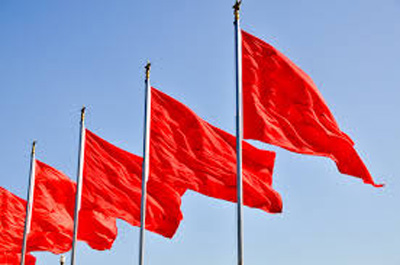10 Red Flags Warn of a Looming Recession
Al Lewis
 Leading economic indicators, tightening credit and a dicey global economy portend a decline Leading economic indicators, tightening credit and a dicey global economy portend a decline
Economists have practically sounded the all-clear on a looming recession, but plenty of signs are still flashing red.
Clearly, economists were wrong earlier this year when they forecast an economic contraction that has yet to manifest. Could they be wrong now?
To be sure, economic growth, the labor market and consumer spending have proven unexpectedly resilient in the face of rising interest rates and elevated inflation. But there are still plenty of signs a recession might still be on its way.
1. An “uncertain outlook” from leading indicators
Many mainstay economic indicators measure the past. So-called leading indicators reflect what likely lies ahead. The Conference Board's U.S. Leading Economic Indexfor July marked its 16th consecutive drop and its longest losing streak since the run-up to the Great Recession in 2007 and 2008.
The index is based on 10 components, ranging from stock prices and interest rates to unemployment claims and consumer expectations for business conditions.
“The outlook remains highly uncertain," said Justyna Zabinska-La Monica, senior manager of business cycle indicators, at The Conference Board. "The leading index continues to suggest that economic activity is likely to decelerate and descend into mild contraction in the months ahead."
2. Consumer confidence is just a hair above recessionary levels
The Conference Board’s consumer confidence index came in at 80.2 in August, hovering just above 80, the level that often signals the U.S. economy is headed for a recession in the coming year.
It is also a leading indicator used to predict consumer spending, which drives more than two-thirds of U.S. economic activity.
3. Consumers are foregoing big-ticket purchases
Retailers report that their customers have shifted their purchasing habits, spending less on furniture and other big ticket items in favor of necessities. They have also been trading down on grocery items, ditching pricier cuts of beef and buying chicken.
“We saw some switch even to some canned products, like canned chicken and canned tuna and things like that,” Costco’s Chief Financial Officer Richard Galanti told analysts on a May conference call.
Consumer spending has remained one of the bright spots in the economy, but most investors expect consumer spending to slow by as early as next year, Bloomberg’s latest Markets Live Pulse survey found.
4. Credit cards are getting maxed out
U.S. consumers ran up their credit card debt past the $1 trillion mark for the first time last month, according to a report on household debt from the Federal Reserve Bank of New York.
Total household debt, which includes home and auto loans, has eclipsed $17 trillion.
The Federal Reserve Bank of St. Louis reports that credit card delinquencies, which are still low compared to periods such as the Great Financial Crisis, are on the rise.
5. Banks are increasingly reluctant to lend
The latest Senior Loan Officer Opinion Survey by the Federal Reserve reports tightening credit conditions across the board, from business loans to home mortgages and consumer credit.
When banks pull back on lending, businesses curb their investments and consumers cut spending, and this trend is expected to continue for at least the rest of the year.
“Regarding banks' outlook for the second half of 2023, banks reported expecting to further tighten standards on all loan categories,” the Fed survey concluded. “Banks most frequently cited a less favorable or more uncertain economic outlook and expected deterioration in collateral values and the credit quality of loans as reasons for expecting to tighten lending standards further.”
6. Corporate bonds are maturing and refinancing them will be costly
Goldman Sachs estimates that $1.8 trillion in corporate debt is coming due over the next two years and it will have to be refinanced at higher interest rates.
The expense will eat up more corporate resources, possibly leading to slower growth and investment.
Recessions occur as debt levels peak and borrowers begin to default. Moody’s has already reported a surge in corporate defaults this year. In the first half of the year, it counted 55, that’s 53% more than the 36 that defaulted in all of 2022.
7. Manufacturing remains in a prolonged post-pandemic slump
Manufacturing has been in decline for 10 consecutive months, as measured by the ISM Manufacturing Purchasing Managers Index. Respondents to the ISM survey reported weaker customer demand because of higher prices and interest rates.
"Orders are in fact falling faster than factories are cutting output, suggesting firms will need to continue scaling back their production volumes into the near future,”writes Chris Williamson, chief business economist at S&P Global Market Intelligence. “An increasing sense of gloom about the near-term outlook has meanwhile hit hiring and led to a further major pull-back in purchasing activity.”
8. 'Cascading crises' could tip the balance of a slowing global economy
China, a growth engine for the past 40 years, is still struggling to recover from the pandemic, global economic growth has fallen below long-term average, and the ailing world could pull the U.S. economy down with it.
Like a plane crash, every economic disaster stems from a confluence of mishaps. Along these lines, G20 nations on Saturday put out a dire warning:
“Cascading crises have posed challenges to long-term growth,” the group said. “With notable tightening in global financial conditions, which could worsen debt vulnerabilities, persistent inflation and geoeconomic tensions, the balance of risks remains tilted to the downside.”
9. The yield curve, a classic recessionary signal, is still inverted
Investors should be paid more for taking a long-term risk than they should for a short-term risk. That’s why the yield on a 10-year Treasury is supposed to pay a higher yield than a 2-year Treasury.
When this is not the case, it’s called an inverted yield curve, and it has long been considered a sign that a recession is due within the next 18 months.
The yield curve for 10-year and the 2-year Treasury has been inverted since July 2022. It’s been inverted for so long that many observers have given up on its reliability — though it still hasn’t been 18 months since it first inverted.
As for history, the yield curve last inverted was in late 2019, just before the pandemic U.S. recession.
10. Inflation is sticky, and the Fed isn’t done
The soft landing scenario that is so widely embraced is based on observations that inflation has dropped precipitously as the economy continues to grow at a healthy pace and the labor market is still holding strong with the unemployment rate at 3.8%.
The Fed, which has raised interest rates 11 times since March 2022 to curb inflation, can now take a bow. The consumer price index, which measures inflation, has come down from a peak of over 9% in June 2022 to 3.2% on its last reading in July.
The next reading on CPI, for August, comes out Wednesday, and it may not have budged much.
Meanwhile, the Fed, which next meets on Sept. 19-20 to decide on interest rates, is holding fast to its 2% target for inflation and will keep rates higher for longer, or possibly even raise them further to meet that goal.
Wall Street traders are not expecting another increase this month, according to the CME FedWatch tool, which is based on Fed funds futures trading.
Policy makers are still waiting to see what happens next after raising rates to their highest level in 22 years. Perhaps those actions have already sent the economy on a path of contraction. Or perhaps they haven’t done enough to continue slowing inflation.
Sticky inflation presents on ongoing risk of a recession.
“I believe we must proceed gradually,” Dallas Fed President Lorie Logan said last week, “weighing the risk that inflation will be too high against the risk of dampening the economy too much.”
 Al Lewis is an American journalist who has served as a columnist for The Wall Street Journal Sunday and MarketWatch. On April 1, 2016, he became business editor of the Houston Chronicle.[1] Al Lewis is an American journalist who has served as a columnist for The Wall Street Journal Sunday and MarketWatch. On April 1, 2016, he became business editor of the Houston Chronicle.[1]
Lewis grew up in Northbrook, Illinois, and earned a bachelor's degree in journalism and political science from MacMurray College in Jacksonville, Illinois, and a master's degree in public affairs reporting from the University of Illinois Springfield.
He has worked as either a financial writer or editor since 1985, including stints at the Amarillo Globe-News, The Gazette (Colorado Springs), and the defunct Rocky Mountain News. From 2001 to 2008, he was business columnist at The Denver Post. From 2008 until 2013, he authored "Al's Emporium", a column for Dow Jones Newswires, a service of Dow Jones & Co.A column he wrote through 2013 for The Wall Street Journal Sunday appeared in about 70 newspapers nationwide; the edition was discontinued in 2015.[2] From 2014 to 2016, Lewis was editor in chief of South Florida Business Journal.[3]Through 2015, Lewis also wrote a blog called Tell It To Al, and over several years, he frequently appeared on Fox Business Network and Denver's NBC affiliate, KUSA (TV).
themessenger.com
| ![[Most Recent Quotes from www.kitco.com]](http://www.kitconet.com/images/live/s_gold.gif)
![[Most Recent USD from www.kitco.com]](http://www.weblinks247.com/indexes/idx24_usd_en_2.gif)
![[Most Recent Quotes from www.kitco.com]](http://www.kitconet.com/images/live/s_silv.gif)


